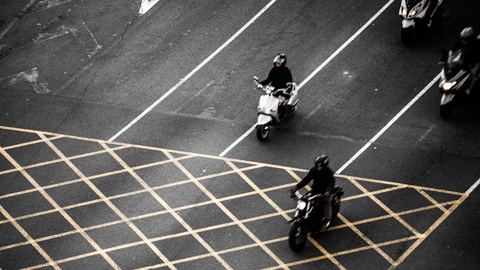Increase in motorcycles converts Barcelona into the European city with the highest number of motorbikes per inhabitant

20/12/2016
The rise in the use of motorbikes in the past ten years has converted Barcelona into the European city with the highest number of motorcycles per inhabitant. This is indicated by a study conducted by researchers from the Institute of Environmental Science and Technology (ICTA-UAB) and the UAB Department of Geography, which clearly shows how the use of two-wheeled vehicles in Barcelona has continuously risen even in a context of deep economic crisis.
In the study it is stated that during the 2004-2012 period the number of motorbikes registered in Barcelona grew by 36.2% reaching 203,414 vehicles, whereas the number of cars decreased by 3.8% down to 584,848 vehicles. Motorbikes represent 22.2% of all motorised vehicles circulating in the city and the number of trips made with this mode of transport has grown to represent 26.5% of all motorised mobility. The research, published in the journal Transport Policy, highlights that the growth has taken place in a context which is characterized by a clear drop in the rates of private motorized mobility, due to the economic crisis which began in 2008.
“The fact that 22.2% of the private vehicle fleet in Spain is motorbikes stresses that this vehicle is an important actor that should be analysed by itself, and we have been able to confirm that it has a different behaviour from the car in times of crisis”, explains Dr Carme Miralles, ICTA-UAB researcher and co-author of the study with Dr Oriol Marquet, researcher of the UAB Department of Geography.
Motorbikes began to experience a boom in 2004 when the Spanish Government enacted a regulatory measure that allowed car drivers with three years of experience to switch to motorbikes with capacity up to 125 cc. The dynamism and speed in trips by avoiding most of the congestions and parking inconveniences promoted its exponential growth, especially among middle-aged veteran car drivers.
The beginning of the economic crisis brought about widespread changes in the mobility of the inhabitants of Barcelona who increased by 39.6% the trips on foot or by bicycle, and by 9.4% the trips in public transport at the expense of cars, whose usage dropped by 14.5%. On the contrary, motorcycle usage not only did not decrease, but instead grew by 18.6%. The motorisation rate in Barcelona grew from 94.5 motorcycles per 1000 inhabitants in 2004 to 136 in 2012.
The study shows that a substantial part (31.8%) of the 372,278 trips that are made every day in two-wheeled motorised modes of transport are performed by middle-aged people between 30 and 64 years of age, mainly males. The research highlights that, although women who ride motorcycles in Barcelona are still smaller in number than men (31.2% of the total), their usage of motorbikes increased by 43.6% between 2004 and 2008. The usage of motorcycles by women in Barcelona is three times higher than the rate for Paris. The rates of satisfaction are higher in those who ride a motorcycle (8.1 out of 10) than in those who drive a car (6.9 out of 10). However, motorcyclist asses a higher sense of insecurity while driving (5.45) than car drivers (3.7).
For the first time, a direct line is drawn between the usage of motorcycles and certain socio-economic variables. The research concludes that motorbike ownership and usage is higher in people with employment and higher education level. "In our opinion, the predictive value of the education level and professional situation can somehow be related to income. This is a very different situation from Southeast Asia and some developing countries, where motorbike ownership is strictly related to income and low-status groups of the population", says Dr Carme Miralles.
Original article:
Marquet, O.; Miralles-Guasch, C. "City of Motorcycles. On how objective and subjective factors are behind the rise of two-wheeled mobility in Barcelona" Transport Policy 2016, vol. 52, p. 37-45